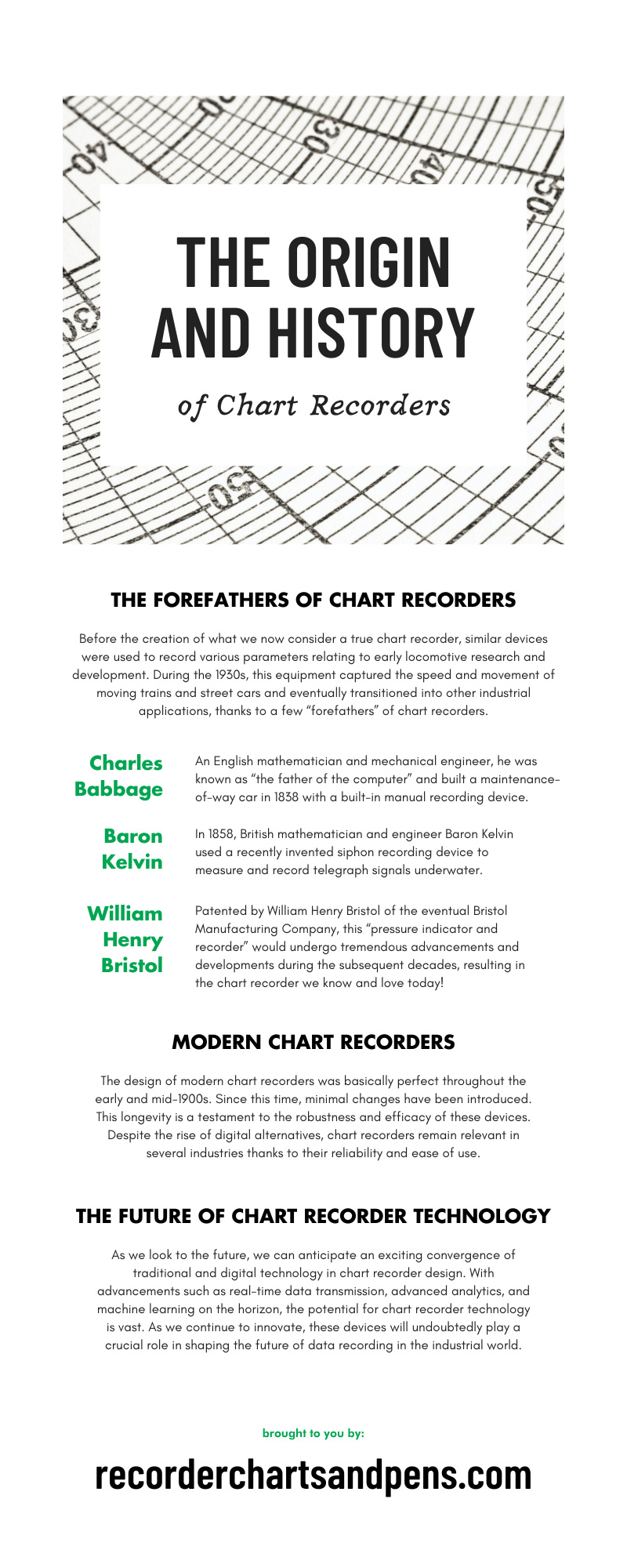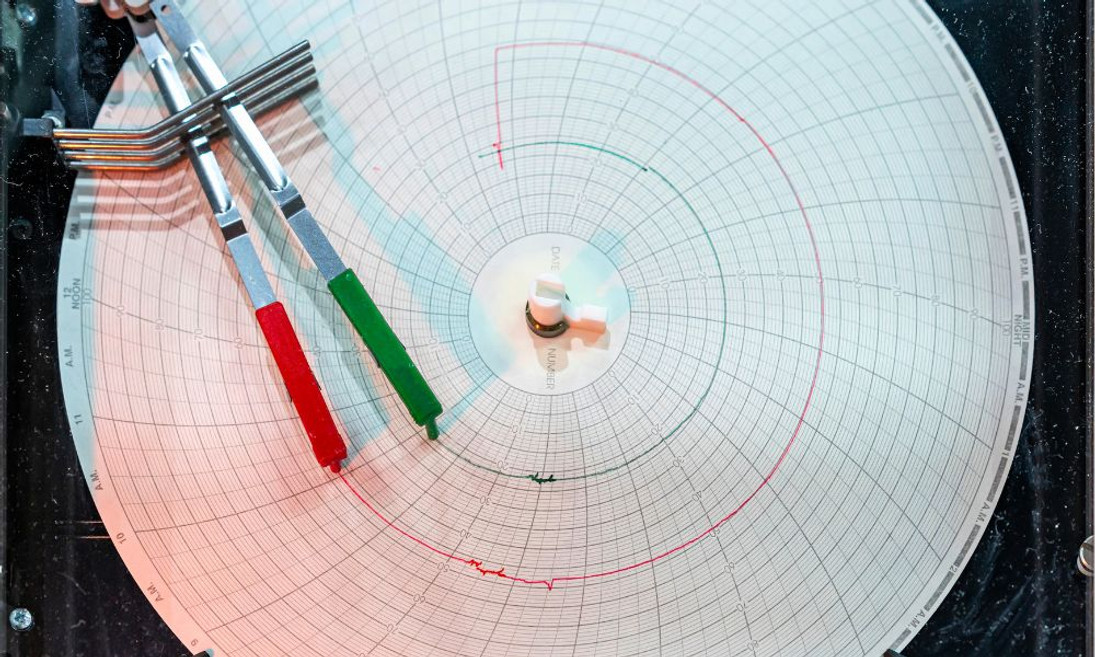5th Oct 2023
The Origin and History of Chart Recorders
Chart recorders play an integral role in a myriad of industrial applications. These electromechanical devices meticulously track and document parameters such as temperature, pressure, flow, PH, humidity, vibration, and movement. Originating from a primitive stage in automated data acquisition, they have evolved into crucial industry tools, steadily recording data on paper with precision and reliability for well over 100 years! The origin and history of chart recorders present a fascinating narrative intertwined with industrial growth and technological progress. This knowledge enhances our grasp of how these devices contribute fundamentally to maintaining industrial standards, regulatory compliance, and product quality.
The Forefathers of Chart Recorders
Before the creation of what we now consider a true chart recorder, similar devices were used to record various parameters relating to early locomotive research and development. During the 1930s, this equipment captured the speed and movement of moving trains and street cars and eventually transitioned into other industrial applications, thanks to a few “forefathers” of chart recorders.
Charles Babbage (English mathematician and mechanical engineer), known as “the father of the computer,” built a maintenance-of-way car in 1838 with a built-in manual recording device. Known as a dynamometer car, this train carriage measured various parameters of the attached railcar, annotating the data with a series of pens onto a 1,000-foot-long rolling strip of paper. The entire chart recording contraption was neatly contained within a table in the middle of the dynamometer car for superior convenience.
By 1850, chart recording devices expanded past locomotive R&D and became the standard studying method for astronomical observations worldwide. In 1858, British mathematician and engineer Baron Kelvin used a recently invented siphon recording device to measure and record telegraph signals underwater. It wasn’t until 1888, however, when the first prototype for a true chart recorder was invented. Patented by William Henry Bristol of the eventual Bristol Manufacturing Company, this “pressure indicator and recorder” would undergo tremendous advancements and developments during the subsequent decades, resulting in the chart recorder we know and love today!
Without Babbage, Kelvin, Bristol, and so many others, we wouldn’t enjoy the many benefits and capabilities of modern chart-recording equipment. Thanks to their ingenuity and contributions, American USGS hydrographer J. C. Stevens was able to perfect the design and invent the first Type A chart recorder in 1911. The Type A was a mechanical environmental monitoring chart recorder that set the standard for chart recorders of the 20th century and beyond!
Modern Chart Recorders
The design of modern chart recorders was basically perfect throughout the early and mid-1900s. Since this time, minimal changes have been introduced. This longevity is a testament to the robustness and efficacy of these devices. Despite the rise of digital alternatives, chart recorders remain relevant in several industries thanks to their reliability and ease of use.
Manual linear and circular chart recorders operate based on a simple yet ingenious mechanism. A sensor picks up the parameter to be measured—temperature, pressure, or any other variable. This sensor is connected to a pen that moves in sync with the changes in the parameter. As the pen moves, it leaves a trace on a paper chart that is continuously rolled steadily. The result is a graph that accurately represents the fluctuating values of the measured parameter over time.
These manual chart recorders serve a multitude of functions in the modern industrial world. They are invaluable in monitoring and maintaining the optimal conditions required in various processes. For instance, in pharmaceutical manufacturing, they help ensure that storage temperatures remain within a specific range to preserve drug efficacy. In the oil and gas sector, they aid in tracking pressure levels in pipelines to prevent accidents. Moreover, the physical record they provide is often crucial for regulatory compliance, as it serves as tangible proof that industrial operations are adhering to the guidelines.
The Future of Chart Recorder Technology
The most notable chart recorder advancement is the rise in popularity of digital data loggers. These advanced devices represent a significant leap from their manual counterparts, offering an array of features that cater to the demands of a rapidly evolving industrial landscape. Data loggers can record numerous parameters simultaneously, storing vast amounts of data electronically and allowing real-time remote access. These capabilities translate into increased efficiency and ease of use, marking a significant step forward in the field of data recording.
However, it is important to understand that these digital devices are not a universal solution. Certain industries continue to rely heavily on manual chart recorders for various reasons. Regulatory compliance often necessitates a physical record of operational conditions, something that manual chart recorders provide reliably. In terms of safety and product quality, these traditional devices offer a level of robustness and accuracy that digital alternatives are yet to match. Their simplicity makes them less prone to malfunctions, ensuring consistent performance even in demanding conditions.
Looking ahead, the evolution of chart recorder technology promises exciting developments. As digital and manual devices continue to coexist, we can expect a fusion of the best features of both worlds. Future chart recorders may embody the robustness and reliability of manual devices, enhanced with the convenience and versatility of digital data loggers. Innovations like real-time data transmission, advanced analytics, and even machine learning integration could become commonplace. As we venture further into the 21st century, the potential for chart recorder technology is limited only by our imagination.
Chart recorders boast a storied history, from their humble origins in the locomotive industry, to becoming vital tools in various industries today. The ingenuity of pioneers like Babbage, Kelvin, and Bristol has given us a device that continues to be relevant despite the advent of digital alternatives. Even as data loggers emerge as the new frontier in data recording, the resilience and reliability of manual chart recorders ensure they maintain a key role in industrial operations.
As we look to the future, we can anticipate an exciting convergence of traditional and digital technology in chart recorder design. With advancements such as real-time data transmission, advanced analytics, and machine learning on the horizon, the potential for chart recorder technology is vast. As we continue to innovate, these devices will undoubtedly play a crucial role in shaping the future of data recording in the industrial world.
Ensure your business has the ideal chart recorder devices and supplies by stocking up on quality products here at Recorders Charts & Pens! Our selection of temperature chart recorder paper and related recording supplies are just what you need for superior regulatory compliance, safety, and product quality.


